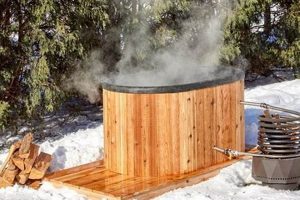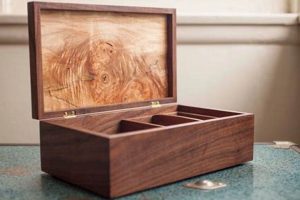Constructing playthings from wood, within a do-it-yourself framework, represents a specific category of handcrafted items. These objects, often miniature representations of real-world items or abstract shapes designed for imaginative play, are created by individuals rather than mass-produced in factories. A simple example would be a pull-along wooden vehicle assembled at home from precut pieces, or a set of building blocks crafted from reclaimed lumber.
The practice of creating playthings in this manner offers multiple advantages. It fosters creativity and problem-solving skills in both the maker and the child using the finished product. Furthermore, it provides a sustainable alternative to commercially available plastic toys, utilizing natural and often renewable resources. Historically, this approach to toy making was commonplace, born out of necessity and a desire to provide children with engaging tools for development and entertainment.
This exploration will delve into various aspects of creating these handcrafted items, including suitable wood selection, essential tools and techniques, safety considerations for design and construction, and project ideas for diverse age groups and skill levels. The focus will be on providing clear instructions and best practices to ensure the successful and enjoyable creation of safe and durable playthings.
Essential Guidelines for Crafting Playthings
The following recommendations aim to improve the safety, durability, and overall quality of handcrafted children’s items.
Tip 1: Wood Selection: Employ hardwoods such as maple, beech, or birch for greater durability and resistance to splintering. Softwoods like pine may be suitable for certain projects but require careful sanding and sealing to prevent damage and ensure safety.
Tip 2: Design Considerations: Avoid sharp edges, small detachable parts, and potential pinch points. Consider the age range of the intended user and design accordingly. Simple, robust designs are often the most effective and safest.
Tip 3: Tool Proficiency: Ensure familiarity with all tools used in the construction process. Proper use of saws, drills, and sanding equipment is crucial for achieving precise cuts, smooth surfaces, and secure joints. Practice techniques on scrap material before commencing the final project.
Tip 4: Joint Integrity: Utilize strong and reliable jointing techniques, such as mortise and tenon, dowel joints, or rabbet joints, to ensure structural integrity. Weak joints can lead to breakage and potential hazards. Glue should be applied liberally and allowed to cure completely before stressing the joint.
Tip 5: Finishing and Sealing: Apply non-toxic, child-safe finishes to protect the wood and enhance its appearance. Avoid paints and varnishes containing lead or other harmful chemicals. Multiple coats of sealant may be necessary to achieve adequate protection.
Tip 6: Hardware Selection: If using screws, nails, or other fasteners, ensure they are appropriately sized and countersunk to prevent protruding edges. Opt for stainless steel or brass hardware to resist corrosion and maintain strength over time.
Tip 7: Thorough Inspection: Before presenting the finished item to a child, conduct a thorough inspection to identify any potential hazards. Check for splinters, loose parts, sharp edges, or any other defects that could pose a risk.
Adhering to these guidelines will contribute to the creation of enduring and secure playthings, fostering a positive and safe play environment for children.
The subsequent sections of this document will further elaborate on specific project ideas and advanced techniques for crafting these items.
1. Material Selection
The selection of appropriate materials is paramount in the creation of durable and safe wooden playthings. The inherent properties of various wood types directly influence the longevity, structural integrity, and overall safety of the finished product. Careful consideration of these factors is essential for mitigating potential hazards and ensuring the creation of age-appropriate and engaging play objects.
- Hardwood Durability
Hardwoods, such as maple, birch, and beech, offer superior density and resistance to wear and tear compared to softwoods. This inherent durability makes them ideal for playthings subjected to frequent handling and impact. Using hardwood minimizes the risk of splintering or breakage, thereby reducing potential injury hazards for children. Hardwoods also accept finishes more readily, enhancing the overall aesthetic appeal and longevity of the item.
- Softwood Considerations
While softwoods like pine and fir are more readily available and cost-effective, their inherent softness necessitates careful preparation and finishing. Softwoods are more susceptible to dents, scratches, and splintering. If softwood is used, meticulous sanding and the application of multiple coats of a durable, non-toxic sealant are essential to mitigate these risks. Additionally, softwood is not suitable for components that require high structural strength.
- Sourcing Sustainability
Sustainable sourcing of wood materials is an increasingly important consideration. Utilizing reclaimed lumber or selecting wood certified by organizations like the Forest Stewardship Council (FSC) promotes environmentally responsible practices. Reclaimed lumber offers unique character and reduces reliance on newly harvested trees. FSC-certified wood ensures that the forest from which the wood originates is managed in a sustainable manner, preserving biodiversity and ecological integrity.
- Toxicity Assessment
Certain wood species contain natural oils or compounds that may be allergenic or toxic. Exotic hardwoods, in particular, should be researched thoroughly before use to ensure they pose no health risks to children. Avoid woods treated with chemical preservatives or insecticides, as these substances can leach out over time and pose a significant health hazard. Selecting wood known for its safety and non-toxic properties is crucial for protecting the well-being of the intended user.
The careful selection of wood materials extends beyond mere aesthetics; it is a fundamental aspect of crafting safe, durable, and environmentally responsible playthings. Prioritizing durable hardwoods, carefully preparing softwoods, considering sustainable sourcing, and assessing toxicity risks are essential steps in ensuring that these handcrafted objects provide years of safe and engaging play for children.
2. Design Safety
The implementation of robust safety considerations within the design phase is paramount when creating playthings from wood. Given the potential for hazards associated with small parts, sharp edges, and material toxicity, a proactive approach to design safety is essential for ensuring the well-being of children interacting with these objects.
- Edge Rounding and Chamfering
Sharp edges pose a significant risk of cuts and abrasions. Incorporating rounded edges or chamfered corners into the design mitigates this risk. Implementing these features during the design phase ensures that potentially hazardous edges are eliminated early in the construction process. These considerations are of particular importance in items intended for toddlers and young children, who are more prone to falls and accidental contact with sharp surfaces.
- Small Part Mitigation
Detachable components that are small enough to be ingested pose a choking hazard, especially for infants and toddlers. Designs must minimize the use of small, detachable parts or ensure that any such parts are securely affixed and cannot be easily removed. Joints should be robust and tested to withstand significant force, preventing unintentional separation during play. Selecting larger components that cannot be swallowed is also a crucial design consideration.
- Non-Toxic Material Selection
The choice of wood and finishing materials directly impacts the potential for exposure to toxins. Wood species should be carefully selected to avoid those with known allergenic or toxic properties. Finishes, including paints, varnishes, and sealants, must be certified as non-toxic and safe for children. Lead-based paints and finishes containing volatile organic compounds (VOCs) are strictly prohibited. The design phase should include a thorough review of material safety data sheets (MSDS) to ensure compliance with safety regulations.
- Structural Integrity and Stability
Designs must incorporate robust structural elements to prevent breakage or collapse during use. Joints must be designed to withstand significant stress and impact. The overall stability of the item is also crucial, particularly for objects designed to be climbed upon or leaned against. A stable design minimizes the risk of tipping or overturning, thereby preventing potential injuries.
The integration of these design safety principles is not merely a procedural step but a fundamental ethical responsibility in the creation of wooden playthings. A proactive and meticulous approach to design safety ensures that these handcrafted objects provide years of safe and enjoyable play for children.
3. Joint Strength
Joint strength is a critical determinant of the safety, longevity, and overall quality of playthings constructed from wood. The integrity of the connections between individual components directly influences the object’s ability to withstand the stresses and strains of regular use. Inadequate joint strength can lead to structural failure, creating potential hazards for children.
- Glue Selection and Application
The type of adhesive employed significantly impacts joint strength. Polyvinyl acetate (PVA) glue, commonly known as wood glue, is suitable for general woodworking applications and provides adequate strength for many plaything joints. However, for joints subjected to high stress or moisture exposure, epoxy resin or polyurethane adhesives may be more appropriate. Proper application of the adhesive is equally important. Surfaces must be clean, dry, and properly prepared to ensure optimal adhesion. Clamping the joint during the curing process is essential for maintaining proper alignment and maximizing bond strength.
- Mechanical Fasteners
Screws, dowels, and nails can supplement or, in some cases, replace adhesive bonding to enhance joint strength. The selection of appropriate fasteners depends on the type of wood being used and the specific demands of the joint. Screws provide superior holding power compared to nails, particularly in hardwoods. Dowels can be used to reinforce butt joints and increase resistance to shear forces. When using mechanical fasteners, it is crucial to ensure that they are properly sized and installed to prevent splitting or weakening the wood. Pre-drilling pilot holes is often necessary to prevent damage and ensure proper fastener seating.
- Joint Geometry and Design
The geometry of the joint itself plays a crucial role in its overall strength. Interlocking joints, such as mortise and tenon joints, dovetail joints, and lap joints, provide significantly greater strength compared to simple butt joints. These joints increase the surface area of the bond and mechanically resist separation. The design of the joint should consider the direction of applied forces. Joints should be oriented to maximize resistance to shear, tension, and compression forces. Careful planning and precise execution are essential for achieving optimal joint strength.
- Wood Species Compatibility
When combining different wood species in a single project, it is important to consider their compatibility and the potential for differential expansion and contraction. Woods with significantly different moisture content or density can create stress within the joint as they respond to changes in humidity. This stress can weaken the bond and lead to joint failure over time. Selecting wood species with similar properties and acclimating them to the same environment prior to construction can mitigate this risk.
The strategic combination of appropriate adhesives, mechanical fasteners, and joint geometry, coupled with careful attention to wood species compatibility, is fundamental to achieving robust joint strength in handcrafted wooden playthings. Prioritizing joint strength not only enhances the durability and longevity of these items but also contributes significantly to the safety and well-being of children using them.
4. Finishing Toxicity
The application of finishes to homemade wooden playthings introduces potential health hazards if improper materials are selected. The toxicity of these finishes, often overlooked, demands careful consideration to ensure the safety of children interacting with the completed items. The selection process must prioritize non-toxic alternatives to mitigate potential adverse health effects.
- Lead Contamination Risks
Older paints and varnishes may contain lead, a neurotoxin that can cause developmental problems, especially in young children. Even trace amounts of lead ingestion through mouthing or handling can be detrimental. Utilizing vintage or repurposed finishing materials carries the risk of lead contamination. Testing suspected materials for lead content prior to application is advisable. Regulatory bodies often provide guidelines and resources for lead testing and remediation.
- Volatile Organic Compounds (VOCs)
Many conventional finishes release VOCs, which are organic chemicals that evaporate at room temperature. These VOCs can contribute to indoor air pollution and may cause respiratory irritation, headaches, and other health problems. Exposure is particularly concerning for children, who are more susceptible to the effects of air pollutants due to their developing respiratory systems. Selecting low-VOC or zero-VOC finishes minimizes this risk. These alternatives typically utilize water-based or natural oil-based formulations.
- Allergenic Components
Certain finishing materials contain ingredients that can trigger allergic reactions in sensitive individuals. Common allergens include formaldehyde, isocyanates, and certain preservatives. Allergic reactions may manifest as skin rashes, respiratory distress, or other symptoms. Reviewing the material safety data sheet (MSDS) for each product can help identify potential allergens. Choosing hypoallergenic or allergen-free finishes reduces the risk of triggering adverse reactions.
- Food-Grade and Child-Safe Certifications
Finishes intended for use on objects that may come into contact with food or that are specifically designed for children should possess relevant certifications. Food-grade finishes are formulated to be non-toxic and inert upon contact with food. Child-safe certifications indicate that the finish has been tested and deemed safe for use on playthings, meeting specific standards for heavy metals, VOCs, and other hazardous substances. Seeking products with these certifications provides an additional layer of assurance regarding safety.
The careful assessment and mitigation of finishing toxicity are integral to crafting safe and wholesome wooden playthings. Prioritizing non-toxic materials and adhering to best practices for application and ventilation ensures that these handcrafted items contribute to a healthy and stimulating play environment for children.
5. Tool Proficiency
The successful creation of playthings from wood hinges significantly on the maker’s level of tool proficiency. This encompasses not only the understanding of each tool’s purpose but also the ability to employ it safely and accurately. Inadequate skill can lead to imperfections in the final product, compromising its structural integrity and posing potential hazards to the user.
- Safe Operation and Handling
The safe operation of woodworking tools is paramount. This includes adherence to manufacturer guidelines, the use of appropriate safety equipment (eye protection, hearing protection, dust masks), and a clear understanding of potential hazards associated with each tool. Improper handling can result in serious injury, highlighting the need for continuous learning and responsible practices. For instance, a lack of familiarity with a band saw could lead to inaccurate cuts and potential blade kickback, endangering the operator.
- Precision Cutting and Shaping
Achieving desired shapes and dimensions requires precise cutting and shaping techniques. Skillful use of saws (hand saws, band saws, scroll saws) allows for accurate cuts along marked lines. Planers and chisels enable the refining of surfaces and the creation of precise joinery. The ability to consistently produce accurate cuts is crucial for assembling components that fit together seamlessly, ensuring the structural soundness of the plaything. Creating a precisely fitted mortise and tenon joint, for example, relies on this precision.
- Surface Preparation and Finishing
Proper surface preparation is essential for achieving a smooth, safe, and aesthetically pleasing finish. Sanding, scraping, and filing techniques are employed to remove imperfections, round edges, and create a consistent surface texture. The application of finishes, such as paints, varnishes, or sealants, requires careful control to avoid drips, runs, or uneven coverage. Poor surface preparation can result in a rough or splintered surface, posing a risk of injury during play. Applying a smooth, even coat of non-toxic sealant enhances both the appearance and safety of the toy.
- Tool Maintenance and Sharpening
Maintaining tools in good working order is critical for both safety and performance. Sharp tools require less force to operate, reducing the risk of slips and accidents. Regular sharpening of blades and chisels ensures clean cuts and prevents tearing of the wood fibers. Proper cleaning and lubrication extend the lifespan of the tools and maintain their efficiency. A dull saw blade, for instance, can bind and kick back, while a poorly maintained hand plane can produce a rough and uneven surface.
The facets of tool proficiency are interconnected and mutually reinforcing. Safe operation enables precise cutting, which in turn facilitates effective surface preparation. Proper maintenance ensures that tools remain sharp and reliable. These combined skills contribute to the creation of safe, durable, and aesthetically pleasing wooden playthings, transforming raw materials into objects that stimulate creativity and provide years of enjoyment.
6. Age Appropriateness
The creation of playthings from wood necessitates careful consideration of age appropriateness. The developmental stage of a child directly impacts their physical abilities, cognitive understanding, and susceptibility to potential hazards. Therefore, plaything design must align with these age-related factors to ensure both safety and engagement. A plaything designed for a toddler, for example, would differ significantly from one intended for a school-aged child. The scale of the item, the complexity of its features, and the potential for small parts all require careful assessment based on the target age group. Failure to adequately address age appropriateness can lead to either a lack of interest or, more concerningly, increased risk of injury.
The practical application of age appropriateness involves several considerations. For infants and toddlers, playthings should be large, durable, and free of small detachable parts that could pose a choking hazard. Smooth surfaces and rounded edges are also crucial to prevent cuts and abrasions. Simple shapes and bright colors can stimulate visual development and encourage exploration. Examples include large wooden blocks, rolling toys with securely attached wheels, and simple stacking rings. As children mature, the design can incorporate more complex features, such as interlocking pieces, moving parts, and opportunities for imaginative play. Playthings for older children might include construction sets, puzzles, and intricate models that challenge their problem-solving skills and fine motor coordination. The level of adult supervision required also varies with age; younger children necessitate closer supervision to ensure safe play.
In summary, the principle of age appropriateness forms a cornerstone in the responsible creation of wooden playthings. It requires a thorough understanding of child development and a meticulous approach to design and construction. By carefully aligning plaything features with the physical and cognitive capabilities of the intended age group, makers can ensure that these handcrafted items contribute positively to a child’s growth and development while minimizing the risk of injury. Challenges may arise in designing versatile playthings that cater to a broad age range, requiring innovative solutions and adaptable designs. The enduring value of wooden playthings lies in their capacity to foster creativity and learning, but this potential can only be realized when age appropriateness is prioritized.
7. Imagination Stimulation
The creation of playthings from wood, particularly within a do-it-yourself framework, presents a potent stimulus for imagination. The inherent simplicity of wooden forms allows children to project their own narratives and meanings onto the objects. Unlike highly detailed, commercially manufactured toys that dictate specific roles and scenarios, basic wooden shapes such as blocks, vehicles, or figures become adaptable props in a child’s evolving imaginative landscape. The cause is the toy’s open-ended design; the effect is the expansion of a child’s creative capacity. The importance of imagination stimulation lies in its contribution to cognitive development, fostering problem-solving skills, narrative creation, and abstract thinking. A real-life example can be seen in a child using a plain wooden block as a spaceship, a building, or a character in a story, showcasing the toy’s versatility in sparking different imaginative scenarios. The practical significance of understanding this connection lies in the ability to intentionally design toys that maximize creative engagement.
Further analysis reveals that the tactile qualities of wood itself contribute to imagination stimulation. The natural grain, texture, and warmth of wood provide a sensory experience that enhances a child’s connection to the toy. This tactile engagement fosters a deeper level of interaction than that typically offered by plastic or other synthetic materials. Moreover, the act of crafting the toysanding, shaping, and finishingcan further amplify the child’s imaginative connection, as they have participated in the object’s creation. A practical application involves incorporating natural imperfections or leaving some surfaces unfinished to encourage tactile exploration and imaginative interpretation. For instance, leaving a knot visible in the wood allows a child to imagine it as a window, a portal, or a character’s eye. This approach contrasts sharply with the uniformity of mass-produced toys, which often lack the character and tactile appeal to deeply engage a child’s imagination.
In conclusion, the link between crafting playthings from wood and imagination stimulation is a synergistic relationship rooted in simplicity, tactile qualities, and open-ended design. While challenges may arise in balancing safety considerations with opportunities for creative exploration, the key insight is that the most effective playthings are often those that provide the fewest constraints on a child’s imagination. The connection to the broader theme of developmental benefits is clear: wooden toys, when thoughtfully designed, can contribute significantly to a child’s cognitive, emotional, and social growth by fostering creativity, problem-solving skills, and narrative abilities.
Frequently Asked Questions
The subsequent questions address common inquiries regarding the creation and utilization of handcrafted wooden playthings. These responses aim to clarify best practices and mitigate potential concerns related to safety, durability, and material selection.
Question 1: What wood types are safest for constructing playthings intended for infants?
Hardwoods such as maple and beech are recommended due to their dense grain structure, which reduces the likelihood of splintering. Softwoods like pine require thorough sanding and sealing with non-toxic finishes to prevent the release of splinters. Any wood treated with chemical preservatives should be avoided.
Question 2: How can small parts be securely attached to minimize choking hazards?
Employ robust joinery techniques, such as mortise and tenon or dowel joints, supplemented with non-toxic adhesives. Mechanical fasteners, like screws, should be countersunk and covered. Regular inspection of the plaything is crucial to identify and address any loosening components.
Question 3: What types of finishes are considered non-toxic and child-safe?
Finishes labeled as “food-grade” or certified by organizations specializing in child safety standards are preferred. Avoid finishes containing lead, volatile organic compounds (VOCs), or known allergens. Water-based acrylics and natural oil-based finishes are often suitable alternatives.
Question 4: How can sharp edges and corners be mitigated to prevent injuries?
Rounding edges with sandpaper or a router is a standard practice. Chamfering corners can also effectively reduce sharpness. Inspect the finished plaything thoroughly to ensure no potentially hazardous edges remain.
Question 5: What is the recommended maintenance procedure for ensuring the longevity of wooden playthings?
Regular cleaning with a damp cloth and mild soap is advisable. Inspect the plaything periodically for signs of wear and tear, such as cracks, splinters, or loose joints. Re-apply sealant as needed to protect the wood and maintain a smooth surface.
Question 6: What are the environmental considerations when selecting materials for crafting wooden playthings?
Opt for sustainably harvested wood certified by organizations like the Forest Stewardship Council (FSC). Utilizing reclaimed lumber reduces the demand for newly harvested trees. Minimize waste by carefully planning cuts and repurposing leftover pieces.
Adhering to these guidelines will contribute to the creation of durable, safe, and environmentally responsible handcrafted wooden playthings. Prioritizing the well-being of the intended user remains paramount.
The subsequent section will delve into specific project ideas and advanced techniques for creating these handcrafted items.
Conclusion
The preceding exploration has elucidated various facets of DIY wooden toys, underscoring critical considerations in material selection, design safety, joint strength, finishing toxicity, tool proficiency, and age appropriateness. These elements are not merely individual components but interconnected factors that determine the overall quality, safety, and developmental impact of the finished product.
The creation of these playthings represents a commitment to safety, sustainability, and fostering imagination. It encourages thoughtful engagement with materials, tools, and design principles. The future of DIY wooden toys lies in continued innovation, adherence to best practices, and a dedication to providing children with safe, stimulating, and enduring play experiences.



![[DIY Guide] Easy DIY Wood Window Shutters You Can Build! The DIY Hub: Creative Crafts, Repairs & Life Hacks [DIY Guide] Easy DIY Wood Window Shutters You Can Build! | The DIY Hub: Creative Crafts, Repairs & Life Hacks](https://craftingdiycenter.com/wp-content/uploads/2025/07/th-3579-300x200.jpg)



